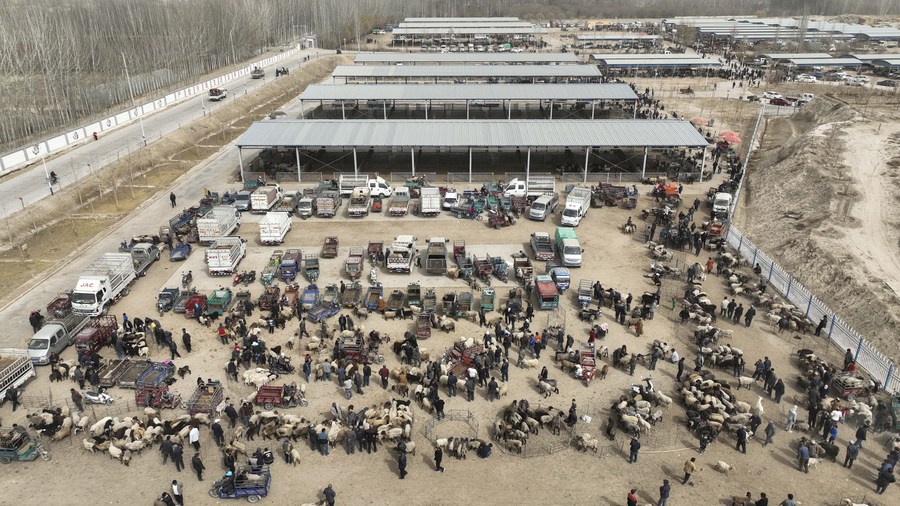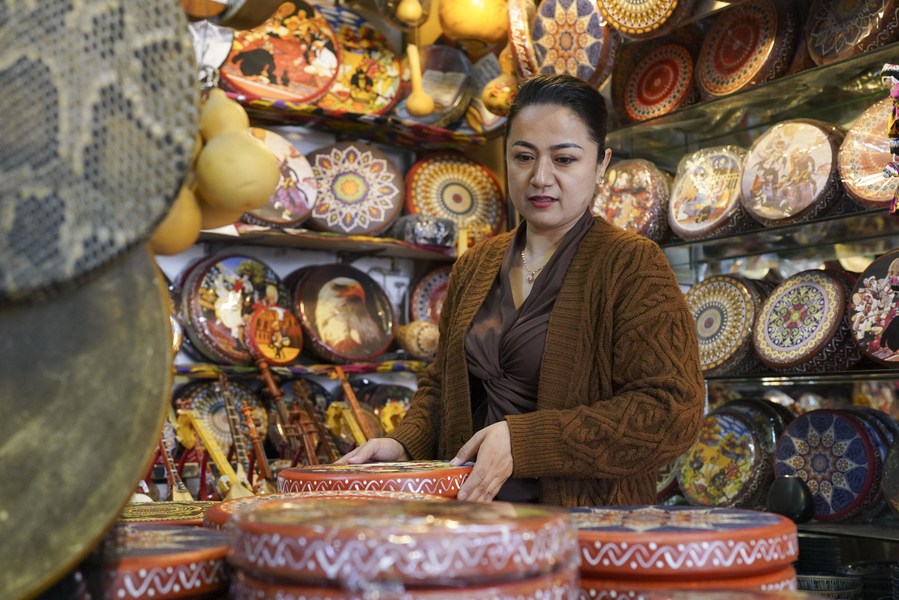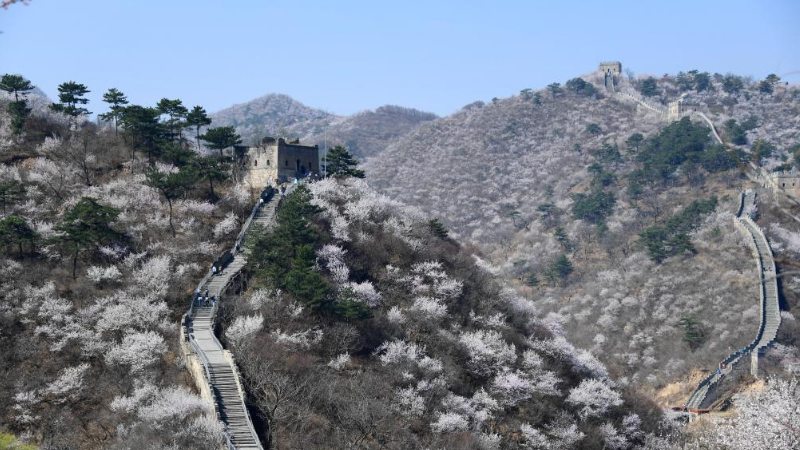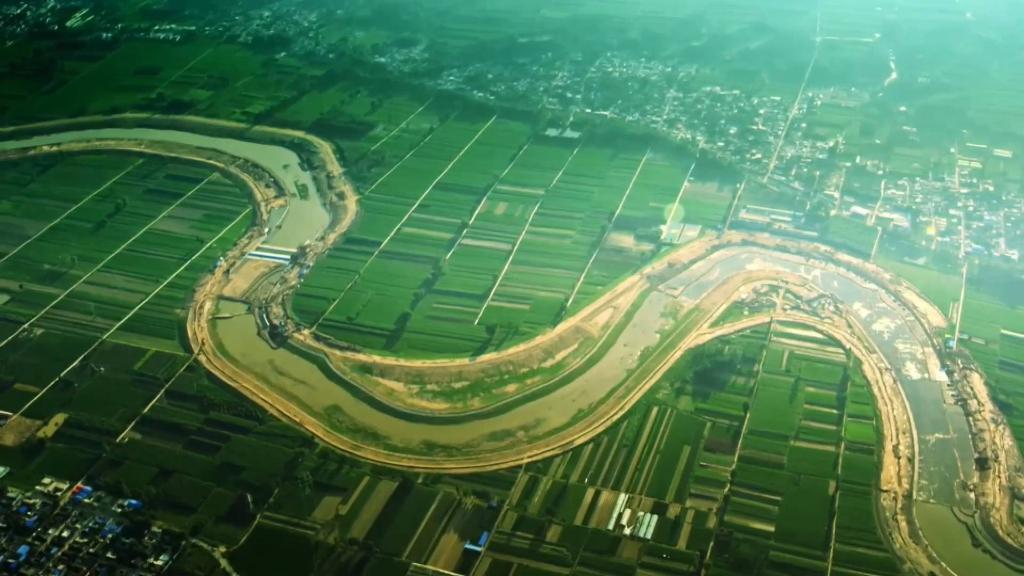* The ancient city of Kashgar in China's Xinjiang Uygur Autonomous Region is an example of the decades of unremitting efforts by the central and local governments to improve the local business environment and infrastructure.
* The bazaar, a mirror of the vitality of the local economy, has also gained new glory thanks to the renovation work in recent years.
* The revamped bazaars have boosted the development of the tourism industry and further enhanced the living standards of people of all ethnic groups in Xinjiang.
URUMQI, April 2 (Xinhua) -- In the early hours, as streaks of pink and orange light pierce through the darkness, the ancient city of Kashgar in China's Xinjiang Uygur Autonomous Region slowly awakens from its slumber. The bazaars on its winding lanes are gearing up for another bustling day.

This photo taken on March 9, 2023 shows the night view of Khan Bazaar in the ancient city of Kashgar, northwest China's Xinjiang Uygur Autonomous Region. (Xinhua/Hu Huhu)
At the Khan Bazaar, the morning air is filled with a tantalizing blend of local ethnic snacks, while the ironware bazaar is filled with the continuous clanging of craftsmen forging their wares. At the same time, medicinal herb and tea merchant Abdul Aini Hailipati welcomes his first customers of the day.
"While the ancient city of Kashgar is tidier and prettier after renovation, the old businesses are still around and our life is filled with hope," Abdul Aini Hailipati said.
Kashgar is an example of the decades of unremitting efforts by the central and local governments to improve the local business environment and infrastructure and to further enhance the living standards of people of all ethnic groups in Xinjiang, China's far-west region.
The bazaar, a mirror of the vitality of the local economy, has also gained new glory thanks to the renovation work in recent years.

Abdul Aini Hailipati (R), a medicinal herb and tea merchant, introduces goods to a customer at the Khan Bazaar in the ancient city of Kashgar, northwest China's Xinjiang Uygur Autonomous Region, March 9, 2023. (Xinhua/Hu Huhu)
REBIRTH OF BAZAARS
The core area of the ancient city of Kashgar is dotted with a wide array of bazaars.
Born and raised in Kashgar, Abdul Aini Hailipati is familiar with the distinct designs and layouts of a variety of featured bazaars -- the jade bazaar, bronze bazaar, hat bazaar, flowerpot bazaar, ironware bazaar, pottery bazaar and musical instrument bazaar.
"In the past, there were many blacksmiths, coppersmiths and other craftspeople in Kashgar, but they were scattered in the city and barely known to tourists," Abdul Aini Hailipati said.
In 2010, a renovation project of the old town was officially launched, with an investment of over 7 billion yuan (about 1 billion U.S. dollars). When it was completed in 2015, the ancient city of Kashgar was certified as a national scenic site with a 5A rating, the highest level of a five-tier tourist attractions rating system in China, and began to attract a growing number of tourists.
Wublkasmu Albunzi, a store owner at the hat bazaar, said business has improved significantly as the renovation enhanced the overall layout and design of different bazaars.
"A large number of tourists from home and abroad are coming here to savor local delicacies in the neighboring food bazaar every day," said Abdul Aini Hailipati.

This aerial photo taken on March 12, 2023 shows a view of a livestock bazaar in Mixa Township of Shache County, northwest China's Xinjiang Uygur Autonomous Region. (Xinhua/Li Xiang)
BRIGHTER FUTURE
At the largest live animal trading bazaar in Shache, the most populous county in southern Xinjiang, Ayigamali Tursun has been on duty twice a week since becoming a market manager there in 2015.
Every Thursday and Sunday when the bazaar is open for livestock trading, nearly 10,000 people gather here, bringing cattle, sheep, horses and other kinds of farm animals to the 13-hectare bazaar.
"In recent years, the livestock bazaar has become increasingly prosperous. Some who live as far away as Aksu and Hotan even come here to trade their livestock. The daily trading volume can exceed 2,000 heads," Ayigamali Tursun said.
In order to facilitate trading and keep it neat and orderly, the bazaar has been divided into several trading zones. "Currently the bazaar can simultaneously accommodate about 20,000 cattle, sheep and 40,000 birds," said Ayigamali Tursun.
The booming trade has created a new occupation -- livestock brokers. They commute between different livestock bazaars that open on different days. "The scale of the livestock bazaar in Shache is very large and is widely favored by the brokers," noted Ayigamali Tursun.
"In recent years, the Chinese government has vigorously promoted rural revitalization. Such bazaars have prompted the development of the local livestock industry and increased the income of local people," said Wang Junhong, deputy director of the agriculture and rural affairs bureau of Shache County.
Wang added that more and more people have purchased trucks and cars to carry their animals, bringing an end to the sight of animals being hauled around in carts.

Maira Abletti arranges goods at her ethnic instruments shop at the Xinjiang International Grand Bazaar in Urumqi, northwest China's Xinjiang Uygur Autonomous Region, March 27, 2023. (Xinhua/Aman)
MULTI-ETHNIC CULTURE FLOURISHES
Maira Abletti, 40, has been running a store selling hand-made drum, dutar, rawap, dombra and other ethnic musical instruments at the Xinjiang International Grand Bazaar in Urumqi, the regional capital, for 13 years.
The Grand Bazaar, inaugurated in 2003, now serves as a key sightseeing and shopping destination in the region, mainly selling local specialties such as dried fruits, medicinal herbs, carpets, jades, ethnic costumes and musical instruments.
"Previously, businesses here were not doing so well, since the bazaar was just a small chaotic marketplace," Maira Abletti said.
In 2018, an expansion and renovation project transformed it into a popular tourist destination, receiving about 50,000 people a day.
Donning festive dresses made of Atlas silk, actresses in the bazaar present tourists with ethnic songs and dances at the bazaar's central stage every day.
"Some tourists volunteer to join them and many dance even better than us. Watching them perform makes me feel very happy and proud," Maira Abletti said.
"The life of people of all ethnic groups in Xinjiang is getting much better. In the meantime, the traditional culture of all ethnic groups is well preserved, and has gathered an increasing number of fans," Maira Abletti said.
"I'm going to make the best instruments and promote them to people all over the world," she added.■
(Reporting by Deng Yushan, Ma Yujie, Li Xiang, Shang Sheng, Wang Kewen, Hu Huhu and A Man; Video reporters: Hu Huhu and A Man; Video editors: Wang Haiyan, Zhu Jianhui, Liu Yutian, Zhang Zhihuan and Miao Zhuang.)












